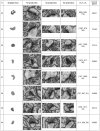Automated detection and segmentation of synaptic contacts in nearly isotropic serial electron microscopy images
- PMID: 22031814
- PMCID: PMC3198725
- DOI: 10.1371/journal.pone.0024899
Automated detection and segmentation of synaptic contacts in nearly isotropic serial electron microscopy images
Abstract
We describe a protocol for fully automated detection and segmentation of asymmetric, presumed excitatory, synapses in serial electron microscopy images of the adult mammalian cerebral cortex, taken with the focused ion beam, scanning electron microscope (FIB/SEM). The procedure is based on interactive machine learning and only requires a few labeled synapses for training. The statistical learning is performed on geometrical features of 3D neighborhoods of each voxel and can fully exploit the high z-resolution of the data. On a quantitative validation dataset of 111 synapses in 409 images of 1948×1342 pixels with manual annotations by three independent experts the error rate of the algorithm was found to be comparable to that of the experts (0.92 recall at 0.89 precision). Our software offers a convenient interface for labeling the training data and the possibility to visualize and proofread the results in 3D. The source code, the test dataset and the ground truth annotation are freely available on the website http://www.ilastik.org/synapse-detection.
Conflict of interest statement
Figures





References
-
- Sterio DC. The unbiased estimation of number and sizes of arbitrary particles using the disector. Journal of Microscopy. 1984;134:127–136. - PubMed
-
- Geinisman Y, Gundersen HJG, Zee E, West MJ. Unbiased stereological estimation of the total number of synapses in a brain region. Journal of Neurocytology. 1996;25:805–819. - PubMed
-
- Mayhew TM. How to count synapses unbiasedly and efficiently at the ultrastructural level: proposal for a standard sampling and counting protocol. Journal of Neurocytology. 1996;25:793–804. - PubMed
-
- Coggeshall RE, Lekan HA. Methods for determining numbers of cells and synapses: A case for more uniform standards of review. The Journal of Comparative Neurology. 1996;364:6–15. - PubMed
Publication types
MeSH terms
LinkOut - more resources
Full Text Sources

